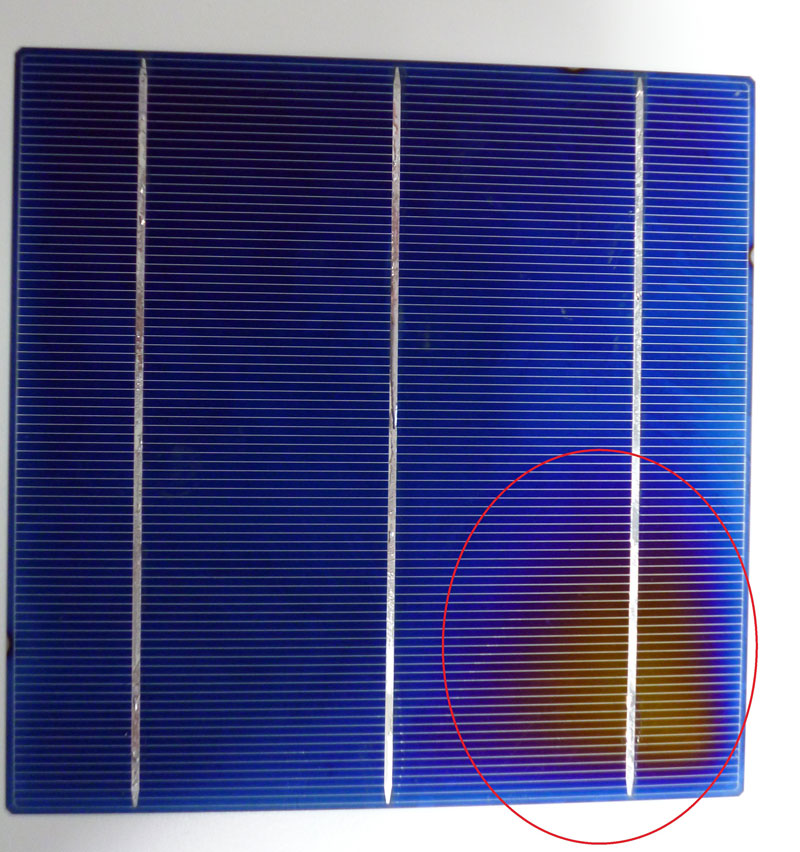With solar cells accounting for 60%+ of the solar panel manufacturing costs, solar cells are the number one component used to cut overall costs of a solar panel.
No need to say, it’s important to ensure that a pv manufacturer isn’t cutting costs on this precious part of your pv module.
From our experience, in the current market situation it’s extremely difficult to source grade B solar cells.
Those cells are often used by quality pv manufacturers to run tests OR by louzy pv manufacturers to cut costs of the pv module.
The worrying question here is: where do all these grade B cells go?
How are grade (A, B, C, D) cells classified?
There’s a lot of confusion between different grade solar cells. Any deviation is often graded as B, however a correct classification is complicated because there are dozens of different solar cell defects that can occur.
This post is a first attempt to design a classification (A, B, C, D) of solar cells, and is a summary of a more in-depth report.
1. Grade A solar cells
Grade A cells are simply without any visible defects, and the electrical data are in spec.
The specifications of the cells can be measured with cell testing equipment.
The perfect grade A cell may still have a slight bend of <= 2.0mm and a tiny color deviation is permitted.
Below a grade A solar cell. Due to the light the color seems to deviate, but in fact, this is a flawless solar cell:

Grade A – solar cell
2. Grade B solar cells
Grade B cells have visible but tiny defects, and the electrical data are in spec.
The following visible defects are common:
- Slight bend of 2.0mm – 2.5mm
- Color deviation, Visible yellow area takes more than 1/4 area of total on the Surface
- Missing prints < 0.5mm
- Part of front Busbar missing, missing area ≤ W:0.5mm×L: 5mm
- Paste leakage, for a single area: 0.3mm – ≤2.0mm2
- Scratch, length 15-50mm
- Water marks, L<15mm,W<2mm
Here a couple of examples of Grade B solar cells:

Grade B solar cell – Color Deviation

Grade B solar cell – Paste Leakage

Grade B solar cell – Large Bend
3. Grade C solar cells
A Grade C solar cell has visible defects, and the electrical data are off-spec.
All solar cells with defects worse than Grade B can be classified as Grade C.
Or
A solar cell can be graded as C when the partly broken cell which could be cut into smaller pieces and re-used.
Here are a number of Grade C solar cell examples:

Grade C solar cell – chipped cell

Grade C solar cell – corner breakage

Grade C solar cell – Busbar Missing

Grade C solar cell – Missing Print

Grade C solar cell – Water mark
4. Grade D solar cells
A Grade D solar cell is broken and can not be cut in smaller cells. There’s not much you can do with these..

Grade D solar cell







Ahsan aziz
on 25 Apr 2019Ouiam
on 07 Aug 2018Dr Sudhir Kumar
on 19 Mar 2018Dricus
on 07 Aug 2018Prakash
on 17 Feb 2018Solarzelle-kaufen
on 28 Apr 2017Abhishek Jain
on 12 Oct 2016Amara
on 20 May 2016Niclas
on 23 May 2016Amara
on 20 May 2016Niclas
on 23 May 2016Amara
on 19 May 2016Niclas
on 20 May 2016Sachin Tiwari
on 21 Sep 2015Raoul Hendrikx
on 06 Jul 2018Dricus
on 22 Sep 2015Peter
on 10 Aug 2015Niclas
on 21 Aug 2015Dricus
on 13 Aug 2015John Theo
on 25 Jun 2015Irvin M.
on 15 Jun 2015Dricus
on 23 Jan 2014Hicham L.
on 23 Jan 2014salman akram
on 08 May 2017Dricus
on 10 Oct 2013Neeraj Thakur
on 27 Sep 2016Abhishek Jain
on 12 Oct 2016Reinier
on 08 Oct 2013